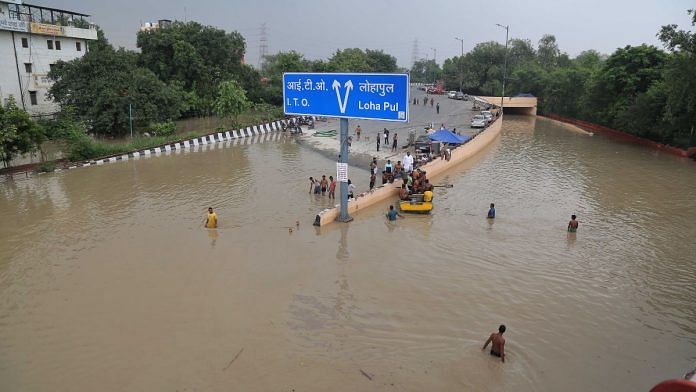New Delhi: After last July’s unprecedented flooding in Delhi, a parliamentary panel has recommended that the central government should intervene and take steps to ensure the synchronised discharge of water from the three barrages in the Delhi stretch of Yamuna river.
In its report on the ‘Review of the Upper Yamuna river cleaning project up to Delhi and river bed management in Delhi’, the panel has recommended that the central government should recalibrate the method of measuring water discharge at these barrages. It has also recommended a Bathymetric survey — an exercise conducted to measure the depths of a water board and map its underwater features — for Yamuna once every five years to address the issue of silt deposition.
The 124-page report, tabled Tuesday during the ongoing Budget session of Parliament, analysed various issues related to river Yamuna, such as the implementation of various central government schemes to help bring down pollution in the river, especially on the Delhi stretch.
Last July, the water level at the old Yamuna bridge had reached a record of 208.66 metres — the previous highest was 207.49 metres in 1978 — due to heavy rains and water release from the Hathnikund barrage in Haryana. This resulted in massive flooding in upscale neighbourhoods such as Civil Lines, near Red Fort and Rajghat, and busy commercial zones on Ring Road and ITO.
Last August, the Parliamentary Standing Committee on Water Resources headed by BJP MP Parbatbhai Patel had carried out a field visit at ITO in Delhi to inspect the role and working of the ITO barrage in flood management in the capital.
One of three barrages on the Delhi stretch of river Yamuna, the ITO barrage is maintained by the Haryana government and was at the centre of the blame game between the Delhi and Haryana governments after five of the 32 sluice gates were found jammed due to silt deposition.
The other two barrages — Wazirabad and Okhla — are maintained by the Delhi and Uttar Pradesh governments.
Officials from the Delhi government’s flood and irrigation department told ThePrint all three barrages have their own calibration for measuring discharge and have not been revised recently.
In its report, the parliamentary panel said: “The committee urges the Department (Water Resources, River Development and Ganga Rejuvenation) to make necessary steps in coordination with the states governments of Haryana, Uttar Pradesh and Delhi to recalibrate the Gauge Discharge Curves of all the three barrages in NCT of Delhi in order to ensure that the discharges from these barrages downstream are in sync with each other”.
Coming under the Union Ministry of Water Resources, the Department of Water Resources, River Development and Ganga Rejuvenation (DoWR, RD & GR) is mainly responsible for laying down policy guidelines and programmes for the development, conservation, and management of water as a national resource.
The parliamentary panel has also recommended that surveys should be carried out at regular intervals to identify vulnerable spots so that necessary action can be taken.
“Bathymetric survey (map the depths and underwater terrain of the river) of River Yamuna should be carried out once in five years or within a specified time-period so that concern of silting of river bed could be addressed and clinical dredging could be done to accommodate the probable flood coming in River Yamuna,” the committee recommended in its report.
Also Read: Why does Yamuna overflow? Encroached floodplains & multiple barrages restricting river flow to blame
‘Resolve the ITO barrage issue at the earliest’
The flooding in Delhi last year had exposed the lack of coordination between the state governments in managing the discharge from the three barrages. It also highlighted the issue of lack of maintenance of the ITO barrage due to the tussle between the Delhi and Haryana governments.
Built by the Punjab government in the 1960s — when Haryana was still part of Punjab — the barrage is meant to provide water to two thermal units of Indraprastha Power Generation Company. While the barrage is located in Delhi, its maintenance is still with the Haryana government.
The flooding last year was caused by the jamming of five sluice gates, which were jammed due to the lack of maintenance. At that time, the Haryana government had reportedly cited the “failure of IPGCL authorities to provide maintenance and operation cost apart from capital investment as per requirement”.
While the Delhi government has asked for the maintenance of the barrage to be handed over to it, the Haryana government has expressed its unwillingness.
In its report, the parliamentary panel noted that the central government had set up a committee under the chairmanship of the Central Water Commission for the joint flood management study of Yamuna’s stretch between Hathnikund and Okhla Barrage. The commission will also review the utility of ITO barrage in the present context, the panel said.
“The Committee feels that this issue needs to be sorted out as early as possible for ensuring the safe operation of the barrage so that the State of Delhi does not again become victim of flooding as witnessed in the month of July 2023,” the parliamentary panel’s report said.
Since the ITO barrage was constructed to supply cooling water for the thermal power houses, it “has no role in flood management in Delhi. The function of ITO Barrage is not for regulation of flood water,” the report said.
The panel also recommends the central government’s intervention to resolve the dispute between the Haryana and Delhi governments. For this, it recommends that the union Department of Water Resources, River Development & Ganga Rejuvenation mediate “and play the role of an honest broker in resolving this contentious issue” by pro-actively engaging all stakeholders.
(Edited by Uttara Ramaswamy)
Also Read: In the same boat, yet not — surviving the Delhi floods, a tale of two localities



